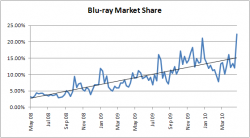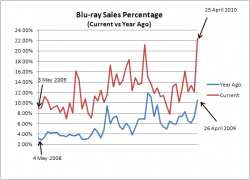Ever since my current TV’s HDMI connection broke, I’ve been looking for a new TV. I almost got a Panasonic in February before discovering the black level problem, and other factors meant that I would be wiser to wait until buying a TV later in the year. Well, it is now later in the year, and what with the 3D hype and everything, I thought it wise to get a 3D ready TV since I could then test various 3D related products, something I found hard to with with the recent review of the 3D enabled new version of PowerDVD. Here in the land down under, the only 3D TV available right now is the new Samsung range, and their pricing is extremely good and I have my eye on the 58″ (the 63″ is a bit too big for my normal viewing distance, I think). The Sony 3D range would be too expensive, and I still prefer plasma, so that leaves only the Panasonic, which the whole black level things has made me think twice about buying a Panasonic TV, plus it’s not out yet and will most likely be more expensive. So barring any unforeseen events, I’ll probably buy the Samsung 58″ (it’s the Aus 7000 series, which is equivalent to the 8000 series in the US). Plus, Samsung is giving away all sorts of free stuff with the TV, including 2 pairs of active shutter 3D glasses and a 3D Blu-ray player, and 2 further pairs plus the 3D Blu-ray version of Monsters vs Aliens for those that get the TV quickly enough. If this is a preview of the type of promotions companies are going to be running for 3D TV, then the next few months could be a very good time to purchase a new TV, even a 2D one, which I’m sure will be discounted accordingly. Anyway, let’s get to the news.

In Copyright news, the MPAA won an important court case against The Pirate Bay in what seems like ages ago, but The Pirate Bay is still up and running, and the MPAA are not too pleased.

The Pirate Bay is still going strong despite losing court cases, so the MPAA is not happy at all
The MPAA wanted TPB to be closed down, but all the co-founders did was to close down the tracker, and the MPAA now wants the co-founders to pay the court imposed fine for not closing down TPB. TPB’s ownership issue has always confused me. I don’t know who owns it and who’s running it, but it seems the co-founders say they aren’t really involved with the website anymore, and that closing down the tracker was probably the only thing they were able to do. But as we all know, trackers are far less important than previously. The MPAA’s various actions to close down trackers has meant the development of open trackers and also decentralised tracking technologies. In other words, the MPAA’s attacks have made BitTorrent much more resilient, and shutting down Torrent download websites or a few trackers won’t really stop file sharing. Even .torrent files are somewhat unnecessary now thanks to magnet links, and DHT means you don’t even need a tracker. And, as we’ve seen in the UK, France and other countries that have adopted three-strikes type laws, people will be moving to anonymous/encrypted BitTorrent services, and this will make even monitoring downloads a hard task for the MPAA. Maybe this will make them happier, you know, ignorance being bliss and all. But somehow, I doubt it. And when this happens, when the MPAA is powerless to stop BitTorrent file sharing or even to find out what people are downloading, then perhaps they’ll redirect their efforts back to tracking down the source of these uploads. While many files are uploaded by individuals, others are done so by well known groups, and it will be hard work for the MPAA to track down and stop these groups, which is probably why they’ve been focusing on the easier job of targeting downloaders.
The Pirate Bay itself has asked for a call to arms, for its users to fight the recently passed UK anti-piracy bill. They want people to speak out against a bill that, in their eyes, is a direct assault on human rights and people’s freedom of expression. The UK general election is just around the corner, but I’m not sure people are able to use this event to protest against the bill, since both major parties seem to support the new anti-piracy measures. Maybe a shock result like the one in Sweden, where The Pirate Party won a seat in the EU parliament, will be the best result from the elections. But for those still unconcerned about the new laws, just ask yourself if you think whether it is appropriate that the government should be spying on your activities, and thus sacrificing your right to privacy, for the sole purposes of protecting the profit of multinational corporations. Don’t buy into all the crap about piracy funding terrorism and crime, because the majority of pirated content are uploaded and made available free of charge, so how would terrorists and organised crime benefit from that? Counterfeit goods, now that’s something else altogether different and it’s big business to sell fake software, movies and games. But three-strikes does absolutely nothing to stop the sale of these goods, and in fact, may promote it further as people too afraid to download pirated content online, and too poor to be able to afford the real stuff, may seek cheap counterfeit goods offline.
Showing the complete lack of class, and the arrogance that we’ve expected from them, a meeting of anti-piracy groups has produced this pearl of wisdom, that child pornography is “great”. Great as in being a great scaremongering tool to use in their efforts to lobby governments, by saying that the same network where people download the latest episode of Stargate Universe is also the same place where child porn is apparently also easily accessible. What nonsense. Based on what I’ve read, downloading of most of these deplorable images and videos are done so on the wider Internet, through public and private forums, private networks, the “darknet”. You certainly won’t find them (or torrents for them) on The Pirate Bay, or the Mininova of old (which didn’t even allow pornographic content of any kind). And does the groups that spy on users for three-strikes even monitor the transfer of child pornography, or images for that matter, or are their filters and tools only set up to detect pirated songs and movies? It’s scaremongering, and making light of an issue that is a million times more serious than college kids downloading a copy of The Hangover, and we’ve already heard from law enforcement agencies that laws like three-strikes actually makes their job of tracking down these criminals much harder, as monitoring of ordinary citizens will force more of them to encrypt their connections to protect their privacy, making it much harder to trace, monitor the truly illegal and dangerous activities of criminals.
And despite evidence that three-strikes actually increases piracy, at least in France, the IFPI, the global trade group for the music industry, says they have evidence that music industry revenue has risen in 2009 for countries where three-strikes has been passed. In countries other than France, at least. And while music industry revenue has risen in Australia, we don’t have three-strikes here, and a federal court even ruled that ISPs are not responsible for the downloads of its subscribers. Revenue increases in the UK also has no correlation to any new government anti-piracy initiatives, which did not pass until just recently. This once again shows how far groups like the IFPI, the RIAA and MPAA will use misleading, if not entirely made up, stats to further their crusade. Overall, the music industry globally recorded a 7% drop in sales. This might sound like a bad thing, but if you have a look at all the competition for our hard earned cash these days, everything from movies to gaming, 7%, with actual growth in 13 territories, is a great result. And all the other forms of entertainment has been seriously innovating, like 3D movies for example, and Blu-ray, and of course gaming, while the music industry has mostly stood still, apart from the move towards DRM-free digital sales, which the music industry was heavily resistant at first. Had they been a bit more enthusiastic at the beginning, they would be the ones with the revenue growth, not Apple with its iTunes store.
And one should not underestimate the amount of damage DRM did for the music industry, but unfortunately, it’s a lesson that the gaming industry is unwilling to learn from. News broke this week that Ubisoft’s “alway on” DRM has been broken. It took a while, given the relatively new status of the DRM, but it’s now finally broken, for both Assassin’s Creed II and Settlers 7. So Ubisoft is now left with an expensive DRM service that they have to keep on maintaining, that does not stop piracy, and whose sole purpose now is to make the overall experience more frustrating for legitimate customers. So basically the story for every single DRM system that has been released so far. When will they learn?

On to HD news now. Avatar has been released and by all accounts, it’s a record breaker for Blu-ray. I will have the weekly numbers posted and analysed on Tuesday in usual place, but the early numbers suggest that overall Blu-ray market share could go above 30% for the first time, and may in fact be the best selling Blu-ray title of all time, even compared to titles like The Dark Knight or Star Trek that has been selling for much longer than a week.

Avatar should break all Blu-ray records
The only reason that Blu-ray wouldn’t reach this historic milestone is that because Avatar is so popular, the DVD version is likely to sell in huge numbers as well. However, the Blu-ray package is a combo, which includes the DVD edition, and most retailers are either only stocking the combo version, or are pricing it only slightly above the plain DVD version, I suspect this will even make non Blu-ray buyers think twice about buying the DVD only version. I mean, the combo version will be much more future proof, and paying an extra $4 to get the Blu-ray version (the current actual pricing difference between the combo and DVD editions, on Amazon.com) makes the combo version the best value.
Meanwhile, the sub-standard Lord of the Rings trilogy Blu-ray has slipped to 19th on the Amazon Blu-ray charts, just barely outselling the 3 year old nature documentary Planet Earth. I’ll leave you to come up with the conclusion for this one.
Decoding of online HD videos on Macs can now be accelerated by the GPU thanks to Adobe’s new preview version of their upcoming Flash version. Name “gala”, the preview provides GPU assisted H.264 decoding for various Macs and Macbooks. Say what you will Flash, and Apple’s Steve Jobs had plenty to say about it (more on that later), but if you want multi-platform H.264 online video support with GPU acceleration, you can’t really beat Flash at the moment, and with the new 10.1 version released in the next month or two, you’ll be hard pressed to find a computer that can’t use its GPU chip to speed up H.264 video decoding. And it’s very much needed as well, because 720p is fast becoming standard for YouTube, and 1080p YouTube videos may finally be watchable on netbooks.
But Flash is still a proprietary third party plug-in, and Apple’s Steve Jobs is not a fan at all. Citing security issues, lack of stability, poor performance for mobile computing, and of course the proprietary nature of the software, Jobs heavily criticized Flash in an open letter published on the Apple website, explaining the lack of Flash support on the iPod Touch, iPhone and now the iPad. Jobs has a point, but Flash still lacks a competent competitors, even just in the limited field of online video, let alone richer applications, and so unless Apple provides an alternative (which would still be proprietary), or if the HTML5 mess is cleaned up, Flash is still very much needed. In fact, one of the bigger criticisms of the iPad has been the lack of Flash support, so perhaps this is Apple trying to deflect some criticism against their new device. Adobe hit back quickly, saying Apple should leave it to consumers to decide whether Flash is good or not, rather than impose the decision on them by not supporting Flash on their devices. They have a point, I think. Look, in a perfect world, we would have an open standard for Flash content, but we’re not there yet. I mean, the whole HTML5 mess, which I’ve tried to explain in this forum post, is only playing into Adobe’s hands.
For PC software news, x264, the popular open source H.264 encoder, is now officially Blu-ray compliant. x264 has been able to encode H.264 clips for use in Blu-ray compilation for some time now, but it has just passed official compliance tests, and so it is quite a big deal. This now allows Blu-ray movies to be converted to DVD, and still maintain Blu-ray compliance (at least for the video stream), and thus making the disc playable in most Blu-ray players (the PS3 apart).

And finally in gaming, more PS3 firmware related news as the latest firmware adds the first steps towards making the PS3 3D capable for gaming. The 3D gaming feature will be available around June/July, but 3D Blu-ray support is only coming later in the year, unfortunately.
In the same update, Sony also laid the groundworks for Sony VAIO PC integration, allowing VAIO PCs to access content stored on the PS3 sometimes in the future.

PS3 will have 3D gaming support added via firmware soon, but it's what's been removed from the firmware that has fans angry
But as Sony adds more features via firmware, users are still displeased at the removal of the Other OS feature. The expected class action lawsuit has been launched. I think the issue most people have with the removal of Other OS is not so much that it was an essential feature, but rather, because Sony had promoted it so heavily, and removing something like this makes people insecure about Sony’s future intentions. Sony’s “It only does everything” tagline for the PS3 is not helping people get over the fact that, well, it no longer does what it did just a few months ago. The other major issue people have is that this effectively stops development on several very promising Linux based media center packages, which can turn your PS3 into a fully fledged media center, a much better one than the default Sony solution. A good third party media center software can really help the longevity of the console, just look at the original Xbox, which is still being used today thanks to software media center mods like XBMC. So while it’s understandable that Sony removed Other OS to prevent a way in for hackers, or the development of emulators, the price of losing a competent third party media center is just too high to pay, perhaps.
And that was that for the week. I’ll have more ranting and complaining for you next week, so until then, have a good one.








